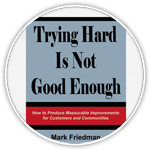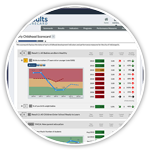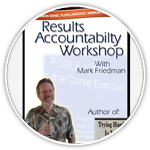This is a popular exercise from the Training for Trainers and Coaches workshop. Graduates from that class often ask where they can get the card decks so they can print them for their own use. Here are the exercise instructions and links to the card decks. Note that the card decks are provided in Word format so that you can change them or create whole new decks from other turn the curve stories. This is an advanced exercise and not intended for RBA beginners.
- The sorting exercise starts with mixed up card decks of elements from a community effort to improve population results. The exercise allows teams to put the cards in the right place in the talk to action thinking process. Select and prepare enough (usually three to five) card decks for each of the following three scenarios so that groups have a choice about what to work on.
- Materials: Card decks, flipchart paper, and masking tape or “blue tac” adhesive.
- Groups write the following categories on a piece of flipchart paper: POPULATION, RESULT (OR OUTCOME), INDICATOR, BASELINE, TARGET, STORY, PARTNERS, WHAT WORKS, PERFORMANCE MEASURE. Leave space between categories for the cards. It is helpful to remind people of the definition of the word target: “A desired future level of achievement for an indicator or performance measure.”
- Scenarios:
- a. Community effort to reduce the Teen Pregnancy rate
- b. Community effort to get All Children Ready for school
- c. Community effort to achieve a Clean Environment
- Each group of 3 or 4 participants will need a separate card deck. A card deck consists of all the cards from one scenario cut up and put together with a rubber band or clip. The card decks should be prepared by printing the scenarios (3 pages each) on different color paper or card stock (e.g. Teen Pregnancy: blue, Ready for School: Red, Clean Environment: Green). Cut each deck into individual cards. MAKE SURE you keep all the cards for a scenario together.
- Debriefing the exercise. The trainer or facilitator goes to each group and checks that the cards are in the right category. If a card is not in the right category, don’t immediately give the right answer, but allow the group to make another choice. Discuss the reasons why the card belongs to the correct category. With the large group discuss what people learned from the exercise.



